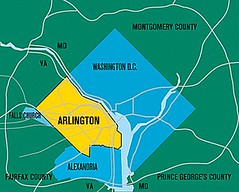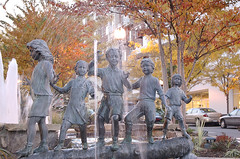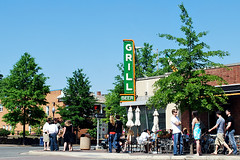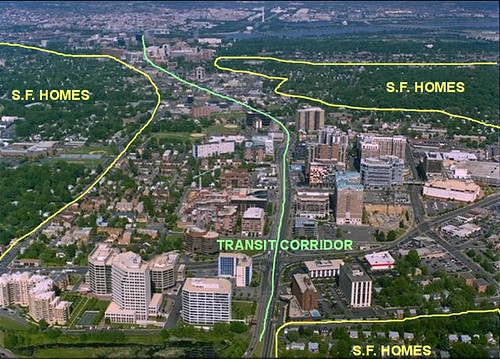Transit-oriented development in Arlington: stunning success and some lessons (part 1)

Posted June 23, 2008 at 1:29PM
The image you see above, of Arlington, Virginia looking north to the Potomac River and Washington, DC, shows one of the country’s most stunning smart growth success stories.
With amazing foresight and gifted planning, Arlington has transformed itself in about three decades from a declining inner-ring suburb into a thriving, bustling and immensely livable community.  This was done by coordinating the county’s (under Virginia law, Arlington is a county, not a city) redevelopment and growth with the region’s Metro subway system.
This was done by coordinating the county’s (under Virginia law, Arlington is a county, not a city) redevelopment and growth with the region’s Metro subway system.
As Roger Lewis put it in Saturday’s Washington Post,
"Arlington planners and politicians were bold, optimistic and foresighted. They insisted that the [Metro line] run underground through Arlington, following Wilson Boulevard and Fairfax Drive, rather than running along the Interstate 66 right of way, which would have been the path of least resistance and at the lowest cost. And they wanted five closely spaced stations [along the route].
"Arlington leaders were predicting, some would say gambling, that the extra cost of running the line underground and building those five stations would someday yield big returns. They expected that billions of dollars of private real estate investment would be attracted to the Rosslyn-Ballston corridor, in turn producing tens of thousands of new jobs, as well as new dwellings, and pulling in new residents, plus many millions of dollars in new tax revenue."
In a nutshell, that is exactly what has happened, and it has brought a range of environmental and community benefits. I am particularly fond of Arlington's Clarendon neighborhood, which seamlessly blends new and old near its Metro stop:


Chris Zimmerman of the Arlington County board notes that the community’s planning goals were to focus redevelopment within walking distance of the Metro station entrances, preserve existing single family and garden apartment neighborhoods and green space, and strive for a 50/50 tax base mix of residential and commercial development.
 Check, check, and check. Since 1980 Arlington has nearly quadrupled both its housing units and office space along the Rosslyn-to-Ballston Metro corridor you see in green above. More people now work in Arlington than in downtown Dallas or Denver.
Check, check, and check. Since 1980 Arlington has nearly quadrupled both its housing units and office space along the Rosslyn-to-Ballston Metro corridor you see in green above. More people now work in Arlington than in downtown Dallas or Denver.
The areas around Arlington’s seven Metro stations (the others are along Jefferson Davis Highway, appropriately running south) produce more than half of the county’s tax revenue, Not coincidentally, Arlington residents now enjoy the lowest tax burden in the metropolitan Washington region. What makes this such a tremendous smart growth story is that all this great development happened without expanding the region's development footprint.
Tomorrow: why Arlington is an environmental as well as planning success story.
